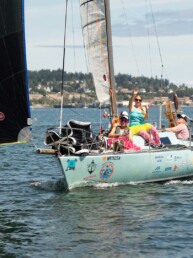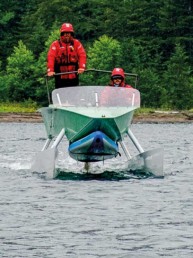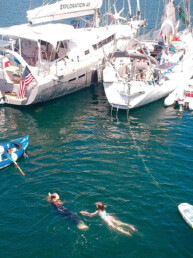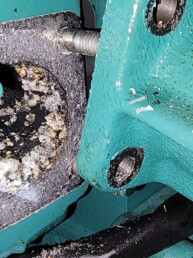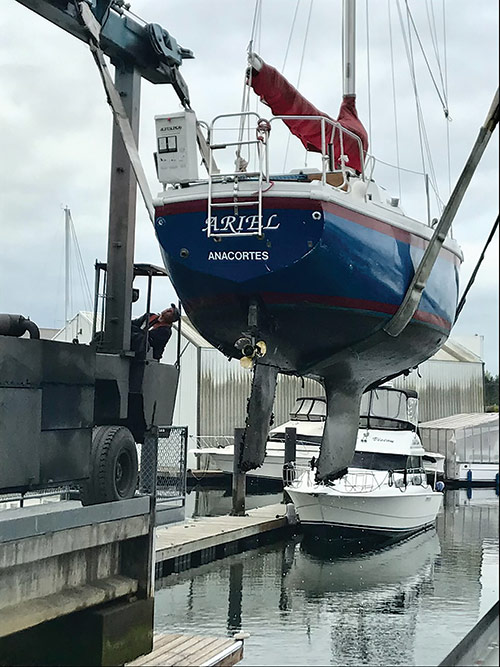
When my wife, Laura, and I were searching for our first boat after moving to the Pacific Northwest, we spent hours reviewing the qualities and characteristics of boats for sale. Being new to boating, we could only guess at what features were “must-haves” and which were “nice but not necessary.”
When we finally settled on Ariel, a 1973 Columbia 28, we really weren’t sure how long we would keep her before trading up to a bigger or newer vessel. On the one hand, we felt that we would own Ariel forever. She’s a sweet little sloop: cute, cozy, and just the right beam and length for novice sailors like ourselves. On the other hand, just about everyone we talked to warned us of one-foot-itis. Apparently, we would eventually outgrow Ariel. But initially, our biggest concern was merely her appearance as much as anything.
Like a home or car, it’s said that a boat never looks better than just after you bought it or just before you’re going to sell it. Our actions certainly proved that adage. In the first weeks after purchasing Ariel, we scrubbed her decks from bow to stern. We sanded and varnished the teak hatch doors and deck handles. We stocked her with coffee, tea, wine, and beer. We cleaned out the alcohol stove and flushed the water tanks. When we proudly displayed Ariel to our dock mates, we were advised that bottom paint was actually more important and preventative than any topside cleaning. While the cost of the bottom procedure was a little shocking, we chose to have it done.
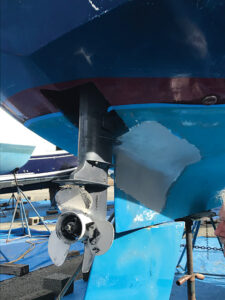
The haulout was exciting to witness, seeing our small boat now looming large out of the water, high above the blacktop of the boat yard we had selected. The barnacles and mussels were thick on the rudder and keel, although they gave up their hold rather easily when scraped with a flat, thick steel shovel. As is so often the case with most jobs, inspections and repairs beget more inspections and repairs.
We were informed by the yard that a large blister-type patch in the aft section of the hull was soft and likely to fail eventually. What we learned was that after Ariel’s original diesel engine had been removed and replaced with an outboard motor in the aft portion of the cockpit, the exit hole for the drive shaft was patched, apparently rather poorly. We were lucky to find a first rate fiberglass technician whose work resulted in a flawless invisible repair, leaving us with a smooth, newly painted bottom to accompany our gleaming topside.
Once you settle into a boat or a house and finally empty the last packing box that often felt like it would find a permanent home in the hallway, you can at last decide what changes will really make it yours. For Ariel, my ideas were different from Laura’s. Since I’m a woodworker and tinkerer, I saw opportunities to add cabinets, enhance storage space, or customize tables or counters. And while Laura is an artist, her idea for making Ariel feel like she was truly ours was not to embellish the boat with more paintings or sketches, but rather to picnic in the cockpit or dine at the cabin table with friends and family.
As it turned out, Laura’s plan was easier to pull off than mine. Within days of owning our nearly-50-year-old boat, we were having lunch at the dock and inviting friends for coffee or a drink. It didn’t matter that Ariel was still tethered to the pier, we were on the water, watching a seal occasionally peek its head up a few feet from our stern, or a trio of ducks splash an awkward landing in the harbor channel. As the months moved on, the Pacific Northwest weather didn’t always cooperate. In fact, the cold, wet and windy winter moved every social event to a below-deck location, accompanied by a heater providing comfort to our chilled feet and legs. But still, boat lunches made Ariel feel more and more like our boat, even if the PNW weather was not cooperative.
During the first few months as boat owners, Laura and I were living in an apartment, with a woodshop for me conspicuously absent from the picture. Once we moved to a house — which happened to be even closer to the marina than the apartment — I immediately commandeered the garage for my shop and looked at Ariel in a new light, revisiting my initial desire to add cabinet work to the V-berth. For months, we had hung colorful flag-banners over three large cut-outs on the inside panel of the berth. It almost seemed like the flags would find a final resting place there, like the unpacked boxes after a home move; but with a three-day cruise looming ahead for us, adding storage space and closing in the cavernous holes that could swallow up glasses or books seemed like a must-do woodworking project, with a lesson in boat structure thrown in.

Traditional cabinet work is very orthogonal — right angles, parallel sides, planar faces. So it was without thought that I built the inset “medicine chest-type” cabinets for the holes. I measured the openings carefully, even planning for the variation in depth from three inches at the lower shelf to five inches at the upper. It was a small challenge that made the project interesting. But when it came time to install the boxes, I was met with a conundrum. The face frames wouldn’t sit flat against the wall. After thinking about it for about half a second, I felt pretty stupid. Of course the wall wasn’t planar. It’s a boat! So, back to the shop to cut away sections of the face frame, and then a return to Ariel for a final fitting and painting, which, while not perfect, satisfied both me and Laura, adding a feeling of safety and comfort to
the berth. Onto the next project.
The repair of the delaminated tiller was a fun woodworking job that also gave me a little experience working with marine finishes. The abundance of wood finishes for furniture pales in comparison to the variety of options for boats. Friends recommended Epiphanes to seal and protect the tiller. After five coats of increasing concentrations, the contoured tiller looked brand new and replaced the temporary linear one that we had purchased at Longship Marine in Poulsbo.
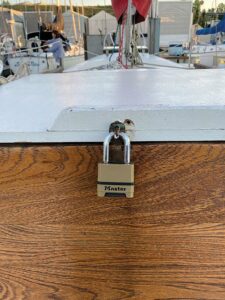
Perhaps the most powerful feeling of ownership came serendipitously while unlocking the combination lock for the hatch doors. We never bothered to change the worn brass padlock from the previous owner or even change the rotating combination. But after a few months of opening and closing, the lock finally gave up the ghost, and the U-shaped ring separated from the casing. With a brand new lock in place on the hatch doors, set with our own personalized four-digit combination, it was as if we finally received the keys to our new house. This was indeed our boat, with our stuff, and our personal touches placed upon her.
Sailing the old girl around Commencement Bay only added to our feeling of ownership. Learning the nuances of how Ariel behaved as she headed to weather or fell off on a comfortable beam reach gave me the confidence and feeling of control that allowed us to relax into our new ownership. While picnics in the cockpit and cabinets in the galley made Ariel feel like our home, trimming her sails and cutting through the waves made her feel like our boat. For a woodworker-turned-sailor, I’m finding that the trim of the sails is far more important than the trim on the cabinets. But I’m still not ready to hang up my hammer yet. You never know what equipment might need a little persuasion to get it back in line.
David Casey is a retired math teacher and semi-professional woodworker and bass player. He plans on using his retirement to build a small sailboat and a kayak, and to explore the waters of southern Puget Sound.

